If your dog or cat requires dental treatment, we may recommend that they also undergo x-rays of their teeth and jaw. Why is this? Why don’t we just remove any teeth that look obviously diseased?
Dental x-rays are required for the diagnosis of some tooth or jaw problems that are just not visible above the gumline, but that can cause progressive pain or damage in your pet’s mouth. Issues that may need diagnosis with dental x-rays include:
Tooth root abscesses
These are infections around tooth roots that can cause significant pain and swelling in the upper or lower jaw. They commonly occur when teeth are broken, allowing bacteria to enter the broken tooth and adjacent gum tissue.
Resorptive lesions
Resorptive lesions occur quite commonly in cats, and look similar to cavities in people, but with an unknown cause. These lesions can be hidden below the gumline on tooth roots, and will cause severe sensitivity and gradual destruction of affected teeth.
Retained teeth
If a pet is missing a tooth, it’s important that we check whether it’s actually just not there (a quirk in some pets!), or whether it hasn’t erupted properly from the jaw. Teeth that are retained in this way can result in progressive jaw bone loss and weakening, and potentially a future fractured jaw.
Tumours in the jaw
Unfortunately, pets can develop tumours in their mouths which can be benign (unlikely to spread) or malignant (causing severe local damage or spreading to other areas of the body). Sometimes, these tumours are only initially detectable on x-ray.
Ideally, pets with visible tooth or gum changes should undergo dental x-rays, as should those missing teeth for unknown reasons, and those with any apparent tooth discomfort.
If you have any further questions about dental treatment options for your pet, ask our experienced veterinary team for further advice.

